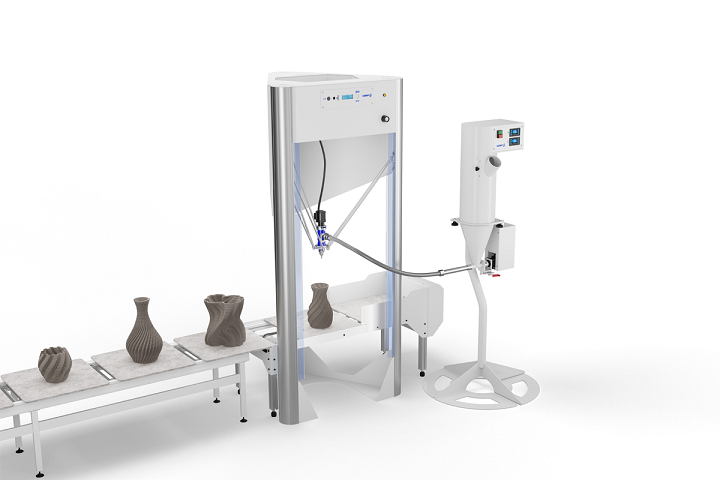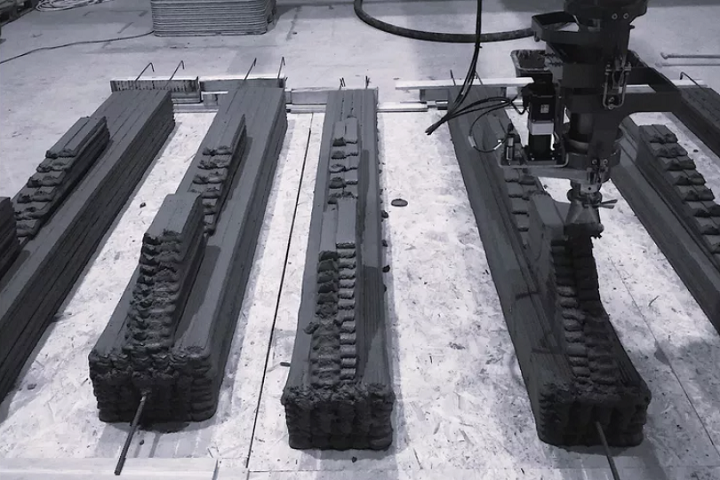We’re starting with a new 3D printer in today’s 3D Printing News Briefs, as Peopoly announces its newly upgraded XXL V2, a massive MSLA system with higher resolution. In continuing news from the recent formnext, WASP presented 3D printers for recycled materials and customized serial production, and BigRep announced a partnership with German standardization authority umati to create a new common framework for machine integration in additive manufacturing. Finally, Minimass is a 3D printed concrete beam that’s much less wasteful.
Peopoly’s New Large-Format Phenom XXL V2 MSLA 3D Printer
Hong Kong company Peopoly, founded in 2016, launched a successful Kickstarter campaign for its Moai resin 3D printer in 2017, and followed with two more Moai models in 2018 and 2019. In late 2019, Peopoly launched its third generation printer series Phenom, followed later that year by the larger Phenom XXL 3D printer, which uses a form of vat photopolymerization called Masked Stereolithography (MSLA). Now, the company is introducing its latest large-format printer: the Phenom XXL V2, with a 527 x 297 x 550 mm print volume. The printer, which also uses MSLA technology, features a next-generation parallel LED array, which is said to offer more even light distribution and sharper focus, resulting in more accurate, higher resolution prints, lower power consumption, less noise, and 30% faster print speed.
Peopoly listened to feedback from advanced users of its Phenom XXL in the automotive, entertainment, and medical industries while developing the Phenom XXL V2, which the company says is over four times bigger than the Form 3L+. The new MSLA 3D printer features a 7″ touchscreen, removable panels for easy maintenance, WiFi and an infrared camera for remote print monitoring and management, an industrial-grade 4K panel, and more. The Phenom XXL V2 also runs the advanced Vlare Core controller board for better performance and more reliable printing, thanks to advanced features like masking and multi-exposure. The new Phenom XXL V2 is available to order now on the Peopoly website.
formnext: WASP 3D Printers for Customized Serial Production & Recycled Materials
At the recent formnext trade show, Italian company WASP- World’s Advanced Saving Project had a large exhibition space and presented two lines of 3D printers, which were designed and developed by two internal vertical teams: LDM for fluid-dense materials, and FDM for polymeric materials. WASP had environmental and economic sustainability on its mind, with a printer line for recycled materials and another for customized serial production. The LDM team showcased a customized serial production line for ceramics 3D printing, featuring a continuous feeding system that degasses the materials, which gets rid of air bubbles and enables an uninterrupted print feed. Additionally, WASP patented a new self-cleaning extruder for those who print mortars, cements, and geopolymers, which is still a niche sector but should develop further in the near future. Its FDM line of 3D printers for the plastic polymer sector included precision printers, and systems with a large print area for sets of materials, including recycled plastics.
“The focus on recycled plastic materials is an increasingly advanced strategic point for WASP which strongly believes in sustainability to protect the environment. With printing systems, pneumatic adhesion systems to the printing surface, systems for filtering printing fumes and anti-wrapping extruders that limit the shrinkage of plastic materials, we are talking about a technological revolution at the service of the environment.”
WASP also introduced the Delta WASP 60100 HDP 3D printer, which supports a liquid-cooled pellet extruder that can print large PEEK parts for industrial applications.
formnext: BigRep & umati Creating Common Machine Integration Spec for AM
Also at formnext, BigRep unveiled its new partnership with umati (Universal Machine Technology Interface), a German standardization authority; the two will work together to create a new common framework specification for machine integration in additive manufacturing, as this doesn’t exist in the AM industry. The lack of standardization is a barrier to mass adoption of the technology, and a strong, common standard could help drive further innovation and ensure interoperability across multiple digital platforms. umati is an open community of machine-building industries working to adopt a standardized interface based on OPC Unified Architecture, and the future UA4AM (UA Interface for Additive Manufacturing) standard, of which BigRep is an early adopter, was designed to facilitate better communication between 3D printers and software like ERP, MES, and PLM. The process was started by VDMA, and over 200 companies are now part of the initiative. UA4AM was presented for the first time in a public space at formnext 2022.
“umati perfectly matches BigRep’s mission towards increased productivity and ease-of-use for our Additive Manufacturing systems and our users in industrial environments. We are open to third-party materials to enable limitless applications; we are open for maximum connectivity to enable fully digital workflows,” said Dr. Sven Thate, Managing Director of BigRep.
Minimass 3D Printing Concrete Beams
Finally, Andy Coward, Founder of Net Zero Projects, is working on new designs for 3D printed concrete structural elements with a focus on low cost and low carbon. He invented its first product in the aptly named Minimass, which is a minimalist, 3D printed concrete beam that requires 78% less concrete, boasts a 70% reduction in steel reinforcement, and, thanks to 3D printing, doesn’t need any formwork. Reinforced concrete has a large carbon footprint, and what’s worse is that most of the concrete in the middle of beams just provides the necessary distance between the top and bottom of the beam. But the Minimass features one chunk of concrete at the top for compression, triangles in the middle, and a post-tensioned cable, instead of conventional reinforcing, in tension at the bottom. Coward, who was motivated to create the Minimass by frustration in “seeing the potential of 3D-printing being wasted,” says the technology enables the beams to be fabricated “at a fraction of the cost of traditional means.”
“At the moment, I am seeing interest in the warehouse/industrial/logistics markets. For example, long-span factory roof beams—normally made from steel but minimass would be cheaper and lower carbon,” Coward said when Treehugger asked where such a beam would be used. “However, my background is projects with more architectural influence, so I also see great possibilities for other typologies such as office/commercial, cultural or large infrastructure e.g airports. Not residential or health, due to their general preference for flat soffits. Imagine a hybrid structure with CLT floor panels and long span minimass beams—releasing the timber building industry from the constraint of 6m [20-foot] grids.”
Subscribe to Our Email Newsletter
Stay up-to-date on all the latest news from the 3D printing industry and receive information and offers from third party vendors.
Print Services
Upload your 3D Models and get them printed quickly and efficiently.
You May Also Like
3D Printing News Briefs, July 2, 2025: Copper Alloys, Defense Manufacturing, & More
We’re starting off with metals in today’s 3D Printing News Briefs, as Farsoon has unveiled a large-scale AM solution for copper alloys, and Meltio used its wire-laser metal solution to...
Etsy Design Rule Change Reduces Selection of 3D Printed Goods
Online marketplace Etsy has implemented a rule change requiring all 3D printed goods on the site to be original designs. The update to the site’s Creativity Standards states, ¨Items produced using...
Siraya Tech Introduces New Elastomer 3D Printing Materials, Including Foaming TPU
California company Siraya Tech, founded in 2019 with a focus on material science, customer focus, and agility, develops high-quality 3D printing materials that meet the needs of creators, hobbyists, and...
3D Printing News Briefs, April 12, 2025: RAPID Roundup
The news from last week’s RAPID+TCT in Detroit just keeps on coming! That’s why today’s 3D Printing News Briefs is another RAPID Roundup of more exciting announcements from the trade...





































